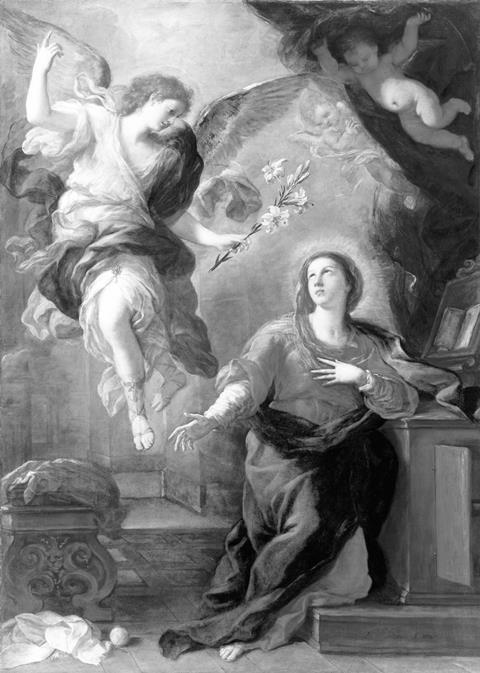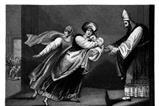Elaine Storkey takes a closer look at two vital angelic visitations in the Christmas story

Study passages: Matthew 1:18-25, Luke 1:26-36
We regularly come across angels in the run-up to Christmas. We see them in displays in shops and online stores, reminding us to buy our presents early. We scrutinise them on Christmas cards, wondering whether to go for classical or contemporary versions.
Parents with primary school children will be kitting out their own little angels with wings for school Nativity plays. And most of us will recall again the angels’ part in the Nativity story, bringing good news to the terrified shepherds and filling the skies with their angelic choir. Angels are seasonal visitors in the UK, showing up especially at this time of year.
Yet, in the biblical accounts, angels were on the scene months before Jesus is born. Nine months in fact. They were the ones who broke the news to the two key players that they were about to become parents. Both Joseph and Mary received a visit from an angel, and detailed accounts of these encounters are given in the Gospels. Yet, when we read those accounts we find they’re very different.
Even though the underlying news was the same – a baby was going to be born from a miraculous conception – the rest of the stories contrast with each other. In Matthew’s Gospel, the focus is on Joseph – he saw an angel when he was struggling with a decision. In Luke’s Gospel the focus is on Mary, and the angel’s visit to her was completely out of the blue. The stories are complementary rather than contradictory, but why are the accounts so different?
The answer lies in the authorship, and the intended readers. Matthew and Luke were very different people, writing about the events of Jesus’ life and death for different audiences and often from different perspectives. Matthew’s is the ‘Jewish Gospel’, written by someone who was part of a Christian Jewish community and who was learned in Jewish history and Hebrew scriptures.
Luke’s Gospel was authored by a Gentile doctor, who was particularly interested in people’s ailments and healings; he also wrote the Acts of the Apostles. And although in both of their accounts we find overlapping material from Mark, much of their narrative is also unique to each of them. This comes out very significantly in the way they present the visits of the angels.
Unpacking the differences
In Matthew’s Gospel the angel visited Joseph in a dream. Joseph had already discovered that his fiancée was pregnant and, since they had not had sexual relations, he knew for certain that the child was not his. Not surprisingly, his conclusion was that the woman he was betrothed to had been unfaithful. The dilemma for Joseph was whether to make her adultery public, which could have had very serious consequences for Mary, or to quietly divorce her (betrothal was as binding as marriage).
Joseph must have thought that the latter option would have left her free to marry the baby’s father, if he were willing, or to go back to her own family. Having decided on that action, Matthew reveals that Joseph was then confronted by an angel in a dream. The angel brought the news that his fiancée had not betrayed him but that her pregnancy was miraculous; she had conceived through the power of the Holy Spirit.
So the angel instructed Joseph neither to expose her as an adulteress nor to divorce her, but to continue into marriage and accept the child as from God. He then gave Joseph instructions on what name to give the child.
The dream was quite brief, and Joseph was unable to ask any questions, yet the encounter so powerful that he was convinced by the angel. He responded by faithfully carrying out what he had been told to do.
In Luke’s Gospel, the angel Gabriel went to Mary before the start of her pregnancy in person to explain to her that she was about to become a mother. Joseph does not feature in this account, except as an absent figure who has not had sex with his fiancée.
Mary’s initial response was, understandably, one of fear and confusion, not least because she knew she was a virgin. She spoke to the angel and received the same information that Joseph did – that the conception would be brought about by the power of the Holy Spirit.
The angel then referred her to her elderly cousin, Elizabeth whose pregnancy, long after the age of conception, was also miraculous – although of a different order. Mary found the angel’s response reassuring, and confirmed that she was God’s servant and willing to accept whatever God had planned for her.

Notice how the gender demarcation in the two accounts is very evident. It also reflects the difference in the background of the authors. Matthew reported the story from Joseph’s point of view, because that was much more in line with the thinking in his Jewish community.
The rights and responsibilities of Jewish men were well laid out. Husbands were the ones with authority in the family, making all decisions – including naming the children. Only they could procure a divorce, and the penalties for an unfaithful wife were heavy ones. Twice elsewhere in his Gospel, Matthew discussed divorce and showed how Jesus urged greater protection for women against husbands who had the power of divorce.
So Matthew’s readers would have been well able to connect with Joseph’s dilemma. From his description of Joseph’s kindness and concern, Matthew seemed keen to offer him as a role model for men – even before he heard from the angel.
Both writers recognised the significance of angels and their roles as God’s messengers
Luke’s account helps us to see the events from Mary’s point of view. His narrative is of a very personal encounter between human and angelic being. Luke did not find it presumptuous of Mary to question Gabriel and, in the conversation between them, Mary was not patronised.
The angel gave her as many details about her baby’s conception as he had himself, but the baby’s future name was not given to her. Instead, through the reference to Elizabeth’s pregnancy, Luke showed an appreciation for the way women relate to each other.
This is all very much in keeping with the rest of his Gospel. More than any other Gospel writer he demonstrated a particular interest in women’s health and wellbeing and in their more vulnerable status. He was the one who highlighted the women who travelled with Jesus and supported him financially. All Luke’s concerns about women are reflected in this story of the angel’s visit.
What do these stories mean to us today?
Matthew and Luke offer us two different cameos of visiting angels. Both writers recognised the significance of angels and their roles as God’s messengers. Together these two accounts give us a richer picture not just of the miraculous conception of Jesus and of angels, but the gender differences embedded within the culture of the Gospels.
The stories help us today in several ways. First they challenge us to reflect more on the biblical narratives, and what we learn from their differences. Especially in the four Gospels, the areas of overlap and the areas of uniqueness are vitally important. They build up a powerful picture of God’s relationship with us.
We never need to set the Gospel writers against each other, because the four authors’ work do not compete or disagree with one another. There are many ways of telling a story and they each give us an authentic account of the life of Jesus, based on the testimony of eye witnesses.
Angels exist where God is at work in our normal, everyday world
The stories also help us to recognise the biblical truth about angels: that they are real. They are not products of our imagination. Nor are they part of the romantic fantasy world that we often see depicted in movies or in stories of the paranormal. They exist where God is at work in our normal, everyday world. They still convey messages from God, they still release people from danger and still prompt and lead the praise of God’s people.
Many people claim to have seen angels and, even though some may be wish-fulfilment, many testimonies are very powerful. Here is one from my own family. After an emergency operation my father’s life was in the balance. I sat by his bedside as the doctors checked constantly, fearing his kidneys may have packed in. His coughing was pulling the wound, and his blood pressure was sinking. With each piece of news, I phoned round our prayer supporters.
As I prayed, I slowly noticed a change; his coughing stopped, his breathing became easier and the tubes connected to his bladder began to fill with urine. He made a full recovery and lived for another 28 years. Afterwards he told me, with utter conviction, that an angel had accompanied him, sitting at the end of his bed, urging him to get better and giving him enormous peace.
We might not always identify our sudden rescue from danger, or new powerful conviction, as the work of an angel. But the Gospels assure us that angels are active even in our world today.
































No comments yet